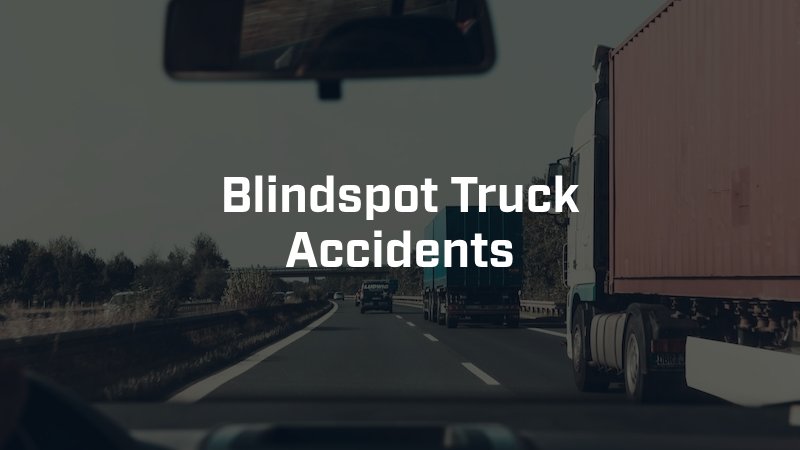Yeah, you’ve probably thought about the gigantic blind spots on large commercial trucks in Arizona. The reality is that these larger vehicles do present more hazards than most other vehicles on the roadway, and this is in large part due to the gigantic blind spots associated with the trucks. Blind spot accidents happen, but determining liability after they happen isn’t easy. Victims should be able to recover compensation, but they often have to jump through hoops to do so.

What Are Blind Spot Truck Accidents?
Blind spot truck accidents occur when a commercial truck collides with another vehicle, cyclist, or pedestrian because they are hidden in the truck’s blind spots. These accidents are common, especially on highways, and are more dangerous due to the size and weight of the truck involved.
Trucks have significantly larger blind spot areas than smaller passenger vehicles, which include the areas directly in front, behind, and along the sides of the truck. These “No Zones,” as they are often called, make it difficult for truck operators to see smaller vehicles, leading to collisions when the truck changes lanes, merges, or makes turns.
Where Are the “No Zones” Around Commercial Trucks?
Understanding the blind spots of a truck, or “No Zones,” can help reduce the risk of accidents. The Federal Motor Carrier Safety Administration (FMCSA) provides clear guidance on these zones to promote safer driving. The primary blind spots on a truck include:
- Front blind spot. Trucks have a large blind spot directly in front due to the elevated position of the driver. A smaller vehicle that cuts in front of a truck may disappear from the driver’s view, creating a risk of a rear-end collision if the truck cannot stop in time.
- Side blind spots. The sides of a truck, particularly the right side, pose the greatest risk. The right-side blind spot extends across multiple lanes, making it especially dangerous for vehicles traveling alongside the truck. Drivers should avoid lingering in these areas for extended periods.
- Rear blind spot. Trucks also have a substantial blind spot directly behind them, making it difficult for the driver to see vehicles following too closely. Tailgating a truck can lead to serious accidents, as the driver may not know you are there, and you may not have enough time to react to a sudden stop.
Common Causes of Blind Spot Truck Accidents
While truck drivers are trained to account for their vehicle’s blind spots, accidents still happen due to several factors:
Driver negligence. Truck drivers should always check their blind spots before changing lanes or turning. However, distracted driving, fatigue, or simply failing to double-check mirrors can lead to accidents. Negligent driving behaviors such as speeding or driving under the influence also contribute to these incidents.
Improper lane changes. One of the most frequent causes of blind spot accidents is improper lane changes by either the truck driver or other drivers on the road. A truck driver who merges without adequately checking their blind spots can collide with vehicles hidden in those areas. Conversely, a car that suddenly merges into a truck’s blind spot can increase the likelihood of an accident.
Weather conditions. Poor weather conditions can reduce visibility and make it even harder for truck drivers to see vehicles in their blind spots. Slippery roads also contribute to difficulty in maneuvering and stopping, exacerbating the dangers of blind spot accidents.
Lack of safety equipment. Modern trucks may be equipped with blind spot monitoring systems, but not all trucks on the road have these advanced safety features. Without these tools, truck drivers must rely on mirrors and their judgment, increasing the risk of an accident if a vehicle is in their blind spot.
Steps to Take After a Blind Spot Truck Accident
If you are involved in a blind spot truck accident, there are several steps you can take right now:
- Seek medical attention. Your health and safety should be the immediate priority. Even if you do not feel seriously injured, seek help from a doctor to ensure that any injuries are documented.
- Document the scene. If possible, take photographs of the accident scene, including damage to your vehicle, the truck, and any road conditions that may have contributed to the crash.
- Gather witness information. If there were witnesses to the accident, collect their contact information. Their testimony may be crucial in determining liability.
- Contact an attorney. Truck accidents often involve complex legal issues, and it is essential to have an experienced Phoenix semi-truck accident attorney on your side to help navigate the claims process and ensure you receive fair compensation.
Why You Should Work With a Truck Accident Lawyer
Blind spot truck accidents can lead to serious injuries, and the legal process for recovering compensation can be overwhelming. An experienced Arizona truck accident attorney can investigate your case, gather evidence, and work to establish liability. They will handle negotiations with insurance companies and represent your interests in court if necessary.
At our firm, we are dedicated to helping accident victims get the compensation they deserve. This can include coverage for medical bills, lost wages, property damage, and non-economic damages such as pain and suffering. Contact us today for a free consultation with an injury lawyer in Phoenix to discuss your case and learn more about your legal options.
